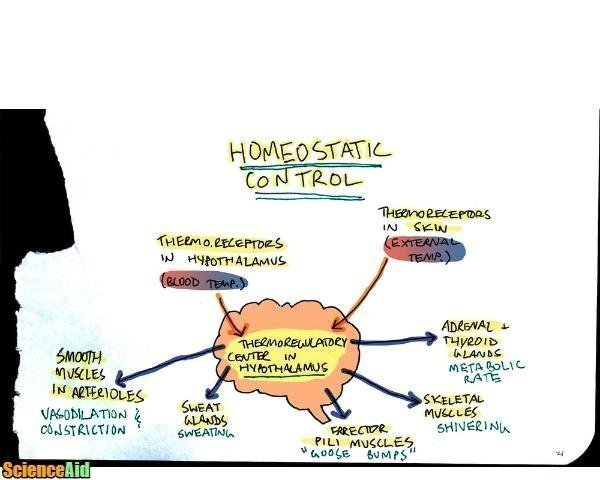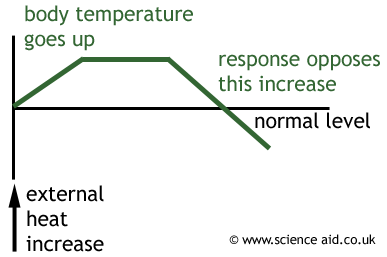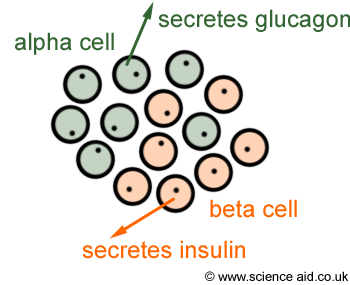Homeostasis: Negative Feedback, Body Temperature, Blood Glucose
Edited by Jamie (ScienceAid Editor), Rj, SmartyPants, Jen Moreau and 8 others
- 1 Homeostasis and Hormones
- 2 Negative Feedback
- 3 Body Temperature
- 4 Blood Glucose
-
5 Questions and Answers
- 5.1 Does sweating involve both the endocrine system and the nervous system?
- 5.2 How does homeostatic help control my body temperature?
- 5.3 Describe generally how a NEGATIVE feedback loop works it comes to temperature regulation of the body?
- 5.4 An important aspect of homeostasis is maintaining a normal body temperature?
- 5.5 Hi Jamie, I need some more information about Negative feedback in homeostasis?
- 5.6 How is skin involved in either in homeostasis?
- 5.7 The brain responded to the demands of exercise by increasing respiration and heart rate. How do these changes contribute to the maintenance of homeostasis?
- 5.8 Can you explain negative feedback steps for homeostasis of blood glucose levels including effector input/output etc?
- 5.9 Hi Jamie.Why do body cells need glucose?Which system activated in response to elevated blood sugar level?
- 5.10 I want to know more thyroid gland and its hormone?
- 5.11 Explain how the body maintains an optimal level of blood glucose?
- 5.12 What could cause a sudden Hypothermic Reaction - random and no obvious cause?
- 5.13 I want to write an Essay about body temperature, what should I include an my sub heading?
- 6 Referencing this Article
- 7 Comments
Homeostasis and Hormones
Homeostasis is the maintenance of a constant internal environment in response to a changing external environment. Hormones have an important role in this system. Hormones are made of proteins, they are released by glands into the bloodstream, where they reach target cells. A specific hormone will fit a specific receptor protein, and this brings about a change in that cell.
Negative Feedback
Negative feedback is the mechanism by which the body maintains conditions within particular limits. The body will do this by opposing a change that deviates from the normal. The diagram below helps to explain this using the example of body temperature.
Note that the opposite change takes the level too far below the normal, therefore a negative response backup will occur, and the process repeats itself, so that over time the temperature oscillates about the normal, within small limits.
Body Temperature
It is important to maintain a constant temperature so that living organisms can maintain metabolism. There are two types of heat regulation: endothermic where the species controls their own temperature (mammals, birds), and ectothermic where temperature reflects the environmental temperature (lizards, fish).
The temperature in mammals is detected by thermoreceptors in the skin and the hypothalamus which is in the brain. Changes in temperature bring about nerve impulses from the brain to the muscles and glands which will bring about changes depending on whether it is hot or cold.
Blood Glucose
The amount of glucose in your blood is carefully controlled. Again, this uses the hormonal system. The hormones responsible for regulating blood glucose are produced in the pancreas in particular areas called islets of Langerhans.
After you have eaten a meal, the blood glucose levels will begin to rise because the carbohydrates in the food are digested and absorbed. This rise is detected by beta cells, which then will produce more insulin. This insulin then binds to receptor proteins in cell membranes (particularly in the liver). This causes more protein channels to open so that more glucose can enter the cell. As well as this, insulin encourages enzymes to convert glucose to glycogen (glycogenesis) for storage.
If however, you have been doing a lot of exercises, and glucose is being used up, then alpha cells will produce glucagon, this causes the release of an enzyme that breaks glycogen to glucose (glycogenolysis [gli-ko-jen-oh-li-sis]).
Questions and Answers
Does sweating involve both the endocrine system and the nervous system?
Silly question, but is sweating an example of where both the nervous system and endocrine system work together? Electrical signals are sent to sweat glands, but as they're glands, surely that also makes it endocrine as well due to the secreting? (or exo as nothing is being secreted into the blood). In the hot/cold table, it is not clear which involves the endocrine system, and which involves the nervous system
Sweating involves both the endocrine and the nervous systems. To regulate the body temperature, the following process happens. There are sensory receptors (part of the nervous system) that can feel the increase of body temperature. Once the body temperature increases, these small receptors feel the increase of the body temperature and send a message to the hypothalamus through sensory neurons. The hypothalamus (belongs to both endocrine and nervous systems), after interpreting the signal secretes a hormone that is carried out by the blood vessels to the sweat glands (effector organ). Once the sweat glands become activated by this hormone, they secrete sweat, thus releasing heat and reducing the body temperature to its normal.
How does homeostatic help control my body temperature?
Using the terms receptors, control center, and effector, explain the homeostatic mechanisms involved in controlling body temperature. Need it for revision on the upcoming exam, don't fully understand it yet. I have tried: Reading other articles, visiting various sites, going over uni lectures. I think it was caused by: I don't understand the explanation, too much information, the way in which my lecturer explains it to me.
To regulate the body temperature, the following process happens. There are sensory receptors that can feel the increase of body temperature. These sensory receptors are like small detectors that can sense any change in the temperature of the body. Once the body temperature increases, these small receptors feel the change and send a message to the hypothalamus through sensory neurons. The hypothalamus (the control center in the brain for the regulation of homeostasis), after interpreting the signal secretes a hormone that is carried out by the blood vessels to the sweat glands (effector organ). Once the sweat glands become activated by this hormone, they secrete sweat, thus releasing heat and reducing the body temperature to its normal.
See more questions like this: Thermoregulation: Describe how the body's homeostatic mechanisms respond to a rise in temperature?
Describe generally how a NEGATIVE feedback loop works it comes to temperature regulation of the body?
Describe generally how a NEGATIVE feedback loop works it comes to temperature regulation of the body.
Once the body temperature increases, the hypothalamus is activated that in turn activates the sweat glands to release sweat and reduce the body temperature. When the body temperature decreases, this message is sent to the hypothalamus by a negative feedback to stop activating the sweat glands. Thus, when the sweat glands are not activated, no sweat is released and the temperature returns to its normal value. (Remember the body temperature should remain constant at all times, therefore, after some time the release of heat should stop and this is done by a negative feedback mechanism)
See more questions like this: Homeostasis feedback system respond to a decreased external temperature?
See more questions like this: Why is blood temperature a negative feedback loop?
An important aspect of homeostasis is maintaining a normal body temperature?
An important aspect of homeostasis is maintaining a normal body temperature. Describe the homeostatic feedback system that would be activated in response to a decreased external temperature
Yes, homeostasis is important to keep everything in the body balanced. The temperature of the body is around 37ºC at all times. If this temperature decreases, it will result in hypothermia (low body temperature), and when it increases it will result in hyperthermia (high body temperature). Both cases are not healthy for the body to function properly and can lead to problems and diseases. When it is cold outside, our body temperature also drops (below 37ºC). The receptors on the blood vessels, that detect these signals, are activated and transmit signals to activate the hypothalamus. The hypothalamus will send signals to the blood vessels. The blood vessels will start constricting to retain heat. It also sends signals to the sweat glands and as a result, these glands will stop secreting sweat. The skeletal muscles are also alerted by the hypothalamus that starts shivering to warm up the muscles and produce heat.
Hi Jamie, I need some more information about Negative feedback in homeostasis?
I have a 400 essay about negative feedback of homeostasis. I am searching to find some useful information to add into my essay. if you have academic sources, I would be more than happy to have them. thanks
Hi, In order to write a good essay about negative feedback of homeostasis, first you should start your essay by defining homeostasis. Then, explain the two types of homeostasis. Talk briefly about positive feedback, and then mention that this essay is about the negative feedback. After explaining negative feedback mechanism, give examples to go deeper into how negative feedback works. And as a conclusion end your essay about the importance of negative feedback mechanism.
I don't know if you are at school or university or college to give you links to reference your essay. You can use the references listed at the bottom of this page. If you are at university and want to go deeper into research and explanation, you can access scientific journals and articles through PubMed, and if you are at school, then refer to your book or check encyclopedia online.
See more questions like this: Negative feedback in homeostasis the role it plays?
How is skin involved in either in homeostasis?
The skin is the largest organ in the human body. And as all organs have a role in homeostasis, the skin plays an important role. The nerve endings in your skin identify changes in temperature and send signals to your brain that your temperature is rising or dropping. Your brain will process these signals and initiate effectors to start regulating the body temperature. Blood flow to the skin also helps regulate body temperature and sweat glands may release sweat through the skin to help decrease temperature. Your skin may also form goosebumps, designed to help you warm up. These are just some of the ways the skin is an important element in homeostasis and negative feedback.
ScienceAid QnA. This section is not written yet. Want to join in? Click EDIT to write this answer.
The brain responded to the demands of exercise by increasing respiration and heart rate. How do these changes contribute to the maintenance of homeostasis?
During exercise, your entire body works hard to maintain homeostasis. When you exercise your muscles are working hard and your body works to ensure the right levels of oxygen are reaching your cells. This increases your breathing rate and also releases carbon dioxide. If too much carbon dioxide builds up during exercise it can lead to a build up of lactic acid during exercise. Lactic acid build-up can inhibit your ability to exercise effectively. This need for oxygen also explains why the heart rate increases. Your body is trying to make more oxygen by pumping your heart harder and moving blood and oxygen away from non-working parts of the body to ones that are working hard. When your body exercises is converts food into energy. This conversion produces a waste product: heat. To try and decrease your temperature, your body will make changes to enable blood flow to the surface of your body and disperse the heat. You will feel this in sweat.
Can you explain negative feedback steps for homeostasis of blood glucose levels including effector input/output etc?
I am having trouble figuring out which receptors are involved! Just need more detail in blood glucose regulation - also is there another name for the Islet of Langerhans?
Please see the new Article: Glucose Regulation: Insulin and Glucagon
The Islet of Langerhans is also known as the pancreatic islets.
See more questions like this: Draw a diagram to illustrate the role of negative feedback in homeostasis. On your diagram explain the role of receptors, control center, and effectors?
Hi Jamie.Why do body cells need glucose?Which system activated in response to elevated blood sugar level?
Sorry my question is why do body cells need glucose?
Please see the new Article: Glucose Regulation: Insulin and Glucagon
I want to know more thyroid gland and its hormone?
When does thyroid gland release the hormone? How does the hormone work in the body? Examples of when it is released. Where can I find that information because I have not found it yet? I have tried: I just looked in this article of homeostasis but I do not see anything about thyroid gland. I think it was caused by: But I do not see the heading of thyroid, or can you please tell me what can I search in order to get it
ScienceAid QnA. This section is not written yet. Want to join in? Click EDIT to write this answer.
Explain how the body maintains an optimal level of blood glucose?
Explain how the body maintains an optimal level of blood glucose. Answer must include what part of the body (organ and cell-type) responds to a rise in blood sugar, what substance is then produced, and how this is used to restore optimal levels. Likewise, answer must include what part of the body (organ and cell-type) responds to a drop in blood sugar, what substance is then produced, and how this is used to restore optimal levels. Make sure your answer includes the use of negative feedback ( you must explain what this actually means). Low levels of glucose not included explanation for it
ScienceAid QnA. This section is not written yet. Want to join in? Click EDIT to write this answer.
What could cause a sudden Hypothermic Reaction - random and no obvious cause?
I've been trying to find out why a patient has a sudden and extremely rapid temperature loss. Within space of no more than 30 seconds, temperature reduces rapidly over whole body - head, legs, arms, face. Face and hands go white. . . When temperature comes back after applying heat treatments, there is pain in back described as "squeezing" by patient.. . Heart monitoring (internal monitor) shows decrease in heart rate but not below critical thresholds.. . If standing, will feel dizzy.. . It seems there are some trigger events, for instance, a slightly colder environment, but this can also happen on a hot or warm day or inside a heated building. Tests done for thyroid and diabetes proved negative, and also Raynaud's phenomenon ruled out. I have tried: Hand heating pads, blankets, hot water bottles can restore body temperature but the problem is diagnosis. I think it was caused by: The heart consultant at the General Hospital has no idea. Two A&E doctors observed it and have no idea. Clearly it is not a phenomenon which effects a large proportion of the population.
A referral may be given to look at possible hormone imbalance, but fishing in the dark at the moment.
ScienceAid QnA. This section is not written yet. Want to join in? Click EDIT to write this answer.
I want to write an Essay about body temperature, what should I include an my sub heading?
My essay should be about 1400 . and I should include this information . 1. Describe what a healthy human core body temperature is?. 2. Why is it needed to be at this value? . 3. How the body temperature is measured, how the body produces heat? . 4. How body temperature is maintained at the desired level?. 5. The mechanism that heat is gained and lost (sweating, distillation, radiation, conduction, convection . 6. The body's homeostatic control of body temperature . 7. The consequences of hypothermia and or hyperthermia, or even frostbite.
ScienceAid QnA. This section is not written yet. Want to join in? Click EDIT to write this answer.
Referencing this Article
If you need to reference this article in your work, you can copy-paste the following depending on your required format:
APA (American Psychological Association)
Homeostasis: Negative Feedback, Body Temperature, Blood Glucose. (2020). In ScienceAid. Retrieved Apr 20, 2024, from https://scienceaid.net/biology/humans/homeostasis.html
MLA (Modern Language Association) "Homeostasis: Negative Feedback, Body Temperature, Blood Glucose." ScienceAid, scienceaid.net/biology/humans/homeostasis.html Accessed 20 Apr 2024.
Chicago / Turabian ScienceAid.net. "Homeostasis: Negative Feedback, Body Temperature, Blood Glucose." Accessed Apr 20, 2024. https://scienceaid.net/biology/humans/homeostasis.html.
If you have problems with any of the steps in this article, please ask a question for more help, or post in the comments section below.
Comments
Article Info
Categories : Humans
Recent edits by: TonyJersey, SarMal, Bokolo














